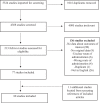Patterns of use and adverse events reported among persons who regularly inject buprenorphine: a systematic review
- PMID: 36229831
- PMCID: PMC9559254
- DOI: 10.1186/s12954-022-00695-5
Patterns of use and adverse events reported among persons who regularly inject buprenorphine: a systematic review
Erratum in
-
Correction: Patterns of use and adverse events reported among persons who regularly inject buprenorphine: a systematic review.Harm Reduct J. 2022 Nov 7;19(1):123. doi: 10.1186/s12954-022-00705-6. Harm Reduct J. 2022. PMID: 36345009 Free PMC article. No abstract available.
Abstract
Background and aims: Given the ongoing opioid crisis, novel interventions to treat severe opioid use disorder (OUD) are urgently needed. Injectable opioid agonist therapy (iOAT) with diacetylmorphine or hydromorphone is effective for the treatment of severe, treatment-refractory OUD, however barriers to implementation persist. Intravenous buprenorphine for the treatment of OUD (BUP iOAT) has several possible advantages over traditional iOAT, including a safety profile that might enable take-home dosing. We aimed to characterize injecting practices among real-world populations of persons who regularly inject buprenorphine, as well as associated adverse events reported in order to inform a possible future BUP iOAT intervention.
Methods: We conducted a systematic review. We searched MEDLINE, EMBASE, and PsycINFO from inception through July 2020 and used backwards citation screening to search for publications reporting on dose, frequency among persons who regularly inject the drug, or adverse events associated with intravenous use of buprenorphine. The review was limited to English language publications and there was no limitation on study type. Study quality and risk of bias was assessed using the Mixed Methods Appraisal Tool. Narrative synthesis was used in reporting the results.
Results: Eighty-eight studies were included in our review. Regular injection of buprenorphine was identified across diverse settings world-wide. Daily dose of oral buprenorphine injected was < 1-12 mg. Frequency of injection was 0-10 times daily. Adverse events could be characterized as known side effects of opioids/buprenorphine or injection-related complications. Most studies were deemed to be of low quality.
Conclusions: Extramedical, intravenous use of buprenorphine, continues to be documented. BUP iOAT may be feasible and results may inform the development of a study to test the efficacy and safety of such an intervention. Future work should also examine acceptability among people with severe OUD in North America. Our review was limited by the quality of included studies.
Keywords: Abuse; Buprenorphine; Intravenous; Misuse; Opioid use disorder; Opioids; Overdose; iOAT.
© 2022. The Author(s).
Conflict of interest statement
Dr. Bozinoff has received grant funding from Canadian Institutes of Health Research, the Academic Health Sciences Alternate Payment Plan, and Womenmind for work outside of this study. Dr. Bernard Le Foll has obtained funding from Pfizer Inc. (GRAND Awards, including salary support) for investigator-initiated projects. Dr. Le Foll has obtained funding from Indivior for a clinical trial sponsored by Indivior. Dr. Le Foll has in-kind donations of cannabis products from Aurora Cannabis Enterprises Inc. and study medication donations from Pfizer Inc. (varenicline for smoking cessation) and Bioprojet Pharma. He was also provided a coil for a Transcranial magnetic stimulation (TMS) study from Brainsway. Dr. Le Foll has obtained industry funding from Canopy Growth Corporation (through research grants handled by the Centre for Addiction and Mental Health and the University of Toronto), Bioprojet Pharma, Alcohol Countermeasure Systems (ACS), Alkermes and Universal Ibogaine. Lastly, Dr. Le Foll has received in kind donations of nabiximols from GW Pharmaceuticals for past studies funded by CIHR and NIH. He has participated in a session of a National Advisory Board Meeting (Emerging Trends BUP-XR) for Indivior Canada and has been consultant for Shinogi. He is supported by CAMH, Waypoint Centre for Mental Health Care, a clinician-scientist award from the department of Family and Community Medicine of the University of Toronto and a Chair in Addiction Psychiatry from the department of Psychiatry of University of Toronto. The other authors declare no competing interests.
References
-
- Opioid and Stimulant-related Harms in Canada. Ottawa: Public Health Agency of Canada; 2021.
-
- Ahmad F, Rossen L, Sutton P. Provisional drug overdose death counts. National Center for Health Statistics; 2022.
-
- Gomes T, Murray R, Kolla G, Leece P, Bansal S, J B, et al. Changing circumstances surrounding opioid-related deaths in ontario during the COVID-19 pandemic. Ontario: Ontario Drug Policy Research Network; 2021.
-
- Holland KM, Jones C, Vivolo-Kantor AM, Idaikkadar N, Zwald M, Hoots B, et al. Trends in US emergency department visits for mental health, overdose, and violence outcomes before and during the COVID-19 pandemic. JAMA Psychiat. 2021;78(4):372–379. doi: 10.1001/jamapsychiatry.2020.4402. - DOI - PMC - PubMed
-
- Mason M, Arukumar P, Feinglass J. The pandemic stay-at-home order and opioid-involved overdose fatalities. JAMA. 2021. - PubMed
Publication types
MeSH terms
Substances
Grants and funding
LinkOut - more resources
Full Text Sources
Medical


